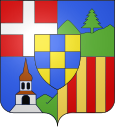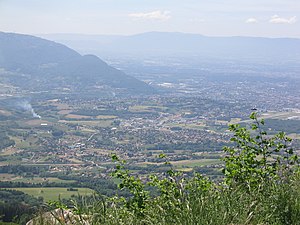Cranves sales
| Cranves sales | ||
|---|---|---|

|
|
|
| region | Auvergne-Rhône-Alpes | |
| Department | Haute-Savoie | |
| Arrondissement | Saint-Julien-en-Genevois | |
| Canton | Gaillard | |
| Community association | Annemasse-Les Voirons-Agglomération | |
| Coordinates | 46 ° 11 ′ N , 6 ° 17 ′ E | |
| height | 439-1,440 m | |
| surface | 13.61 km 2 | |
| Residents | 6,793 (January 1, 2017) | |
| Population density | 499 inhabitants / km 2 | |
| Post Code | 74380 | |
| INSEE code | 74094 | |
| Website | www.cranves-sales.fr/ | |
 Aerial view of Cranves-Sales |
||
Cranves-Sales is a French commune in the department of Haute-Savoie in the region of Auvergne Rhône-Alpes .
geography
Cranves-Sales is located at 531 m , about eleven kilometers east of the city of Geneva (as the crow flies). The village extends on a hill between the Annemasse plateau and the Nussance valley, at the western foot of the Les Voirons mountain range , near the border with Switzerland .
The area of the 13.61 km² municipal area includes a section of the lower Arvetal and the adjacent heights. The southern boundary of the municipality runs along the Menoge , a right tributary of the Arve, whereby the hardly touched valley is sunk around 50 m into the surrounding plateaus. From this course of the river, the municipal area extends northwards to the Annemasse plateau to the Bois des Rosses forest and to the Cranves-Sales hill, a lateral moraine of the Ice Age Rhone glacier . This moraine height is limited to the east by the Nussance valley , which runs parallel to the foot of the Les Voirons mountain range. Beyond the valley, the communal soil extends over the open slope to the densely wooded ridge of the massif of Les Voirons, the northern border being formed by the erosion channel of the Chandouze stream . On the Pointe de Brantaz the highest point of Cranves-Sales is reached with 1440 m .
The community consists of the districts of Cranves and Sales and various hamlet settlements, including:
- Rosses ( 526 m ) on the edge of the Annemasse plateau
- Montagny ( 500 m ) on a ledge between the Nussance and Menoge valleys
- La Bergue ( 509 m ) on the plateau at the foot of the slope of Les Voirons
- Lossy ( 590 m ) on a terrace on the western slope of Les Voirons
- Martigny ( 712 m ) on the western slope of Les Voirons
- Chez le Noble ( 770 m ) on the western slope of Les Voirons
- Armiaz ( 927 m ) on a terrace on the western slope of Les Voirons
Neighboring municipalities of Cranves-Sales are Saint-Cergues in the north, Boëge , Saint-André-de-Boëge and Lucinges in the east, Bonne and Arthaz-Pont-Notre-Dame in the south and Vétraz-Monthoux , Annemasse , Ville-la-Grand and Juvigny to the west.
history
The municipality of Cranves-Sales was settled in prehistoric times. A dolmen from this time was destroyed in 1863. The Romans also settled in the area, which has been proven by finds of foundations of a Roman country house and an aqueduct.
The place name Cranves probably goes back to the Celtic word cranava , which is made up of the components caran (oak) and ava (water).
Cranves was first mentioned in writing around the year 1000 when the Bishop of Grenoble ceded lands to the Count of Geneva. Sales first appeared in the documents in 1317. The two parishes were merged in 1801. Another change of area took place in 1868, when the hamlet of Rosses, which had previously belonged to Vétraz-Monthoux, also joined Cranves-Sales.
Attractions
The church of Cranves originally dates from the 13th century. The bell tower is still preserved from this period; the remaining parts are the result of major changes in the 16th century and from 1890.
population
| Population development | |
|---|---|
| year | Residents |
| 1962 | 1,060 |
| 1968 | 1,296 |
| 1975 | 2,001 |
| 1982 | 2,753 |
| 1990 | 3,931 |
| 1999 | 4,358 |
| 2005 | 5,230 |
With 6,793 inhabitants (as of January 1, 2017), Cranves-Sales is one of the medium-sized communities in the Haute-Savoie department. Since the beginning of the 1960s, thanks to the attractive residential area, there has been continuous strong population growth. Outside the old village center, numerous single and multi-family houses have been built on the promising slope of Les Voirons.
Economy and Infrastructure
Until well into the 20th century, Cranves-Sales was a predominantly agricultural village. Today there are various local small and medium-sized businesses. A larger industrial zone has developed on the road to Annemasse in recent decades. Meanwhile, Cranves-Sales belongs to the agglomeration of Annemasse. Numerous workers are commuters who go to work in the larger towns in the area, especially in the Geneva-Annemasse area.
The place is well developed in terms of traffic. It is between the main road D907, which leads from Annemasse to Taninges , and the road D903, which connects the A40 motorway to Thonon-les-Bains . The closest connection to the A40 is around 7 km away.
